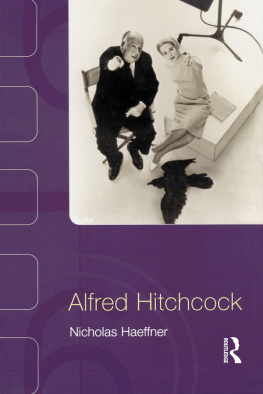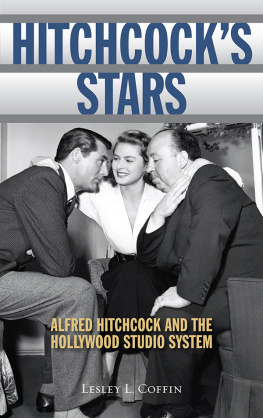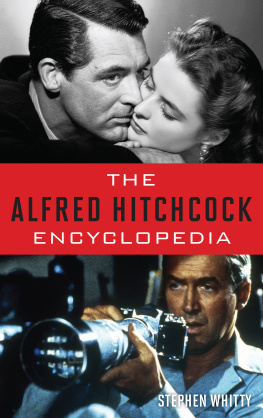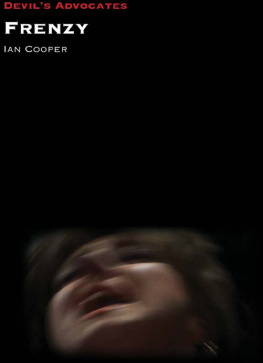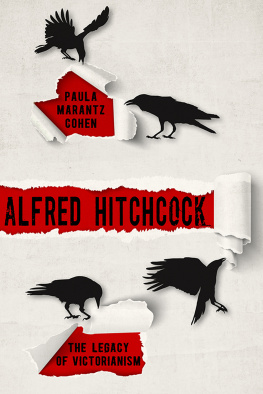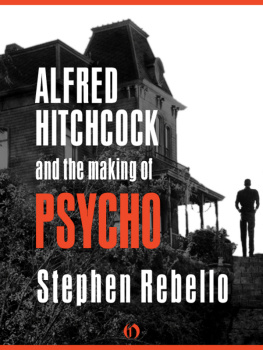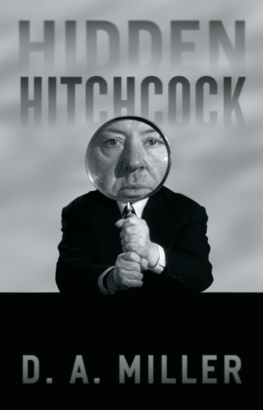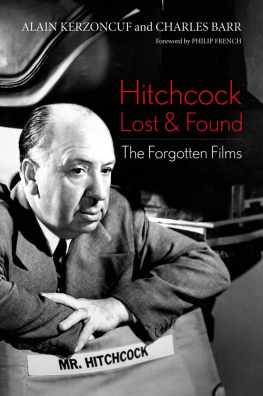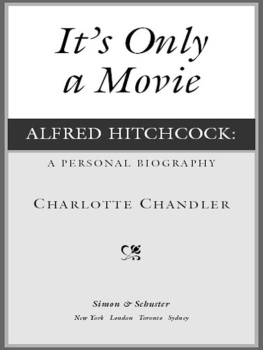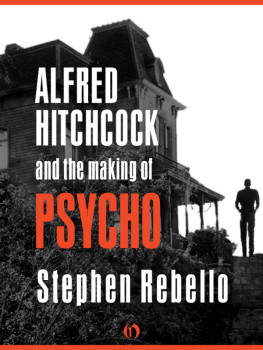Hitchcocks heritage: class, culture and cosmopolitanism
In an article for a French journal published in 1960, Hitchcock confessed that subconsciously we are always influenced by the book that weve read. The novels, the paintings, the music and all the works of art in general, form our intellectual culture from which we cant get away. Even if we want to (Gottlieb, 1997, p. 142). Hitchcock immersed himself deeply in many different forms of culture, soaking up all he could, frequently displaying the breadth of his knowledge in interviews. Jay Presson Allen, who wrote the screenplay for Marnie (1964), puts Hitchcocks thirst for knowledge down to his sense of being uneducated. He was very defensive about class. He had no education but read a lot. People like that are sponges and learn a lot from educated conversations (in McGilligan, 1997, p. 24). Its important to establish at the outset that one of the unique features of Hitchcocks films, which partly helps to explain their status as both popular culture and high art, lies in Hitchcocks own objective class position, which was poised between his familys working-class roots and his own cultural aspirations. The former gave him a firm grounding in popular culture, while the latter led him to absorb influences which are more usually associated with elite culture. The resulting cinema, as Hitchcock understood, was neither highbrow nor lowbrow but rather part of an emerging culture of the middlebrow.
Hitchcock was one of the key figures in the development of a British middlebrow cinema, which aimed to combine cultural respectability with more popular sensationalist fare. Lawrence Napper has suggested that the growth of a middlebrow theatre and cinema during this time was an inevitable consequence of the emergence of the new suburban middle class anxious to consolidate hard-won but precarious improvement in social position and living standards (2000, p. 115). Hitchcock frequently spoke of the need for a middle-class cinema in Britain and emphasised the distinctive qualities of English films when compared to American ones. My policy, he announced to the Daily Herald , is to make popular pictures which anybody can understand. But without being highbrow, I believe in making them in such a way that they will appeal to the most intelligent people as well (Spoto, 1983, p. 135).
Although Hitchcock sought to make middlebrow films in the mainstream film industry, he was, like many other pioneer figures in cinema, something of a cultural outsider. As English Catholics, the Hitchcock family were part of a small, and to some extent dissenting, community within the wider culture of the time. The tradition of Roman Catholicism stresses the ideas of original sin and guilt. Catholicism is most obviously highlighted in the characters of Michael Logan (Montgomery Clift) in I Confess (1951) and Manny Balestrero (Henry Fonda) in The Wrong Man (1957), who are both devoutly religious. Both men take on the burden of guilt of another man, an idea which was a key motif of Hitchcocks work. But the Catholic abhorrence of sin is even more deeply woven into the texture of Hitchcocks films through the manner in which his heroes are punished for their sinful wishes as well as for their deeds. Thus the innocent Guy Haines (Farley Grainger) in Strangers on a Train (1950) is aligned to the murderer Bruno Anthony (Robert Walker) not by action but by thought: although he did not strangle his wife, Miriam (Laura Elliot), he has already confessed in a rage that he could break her foul, useless little neck.
Much Catholic culture has treated sexuality as dangerous, especially female sexuality. Since it was Eve who tempted Adam into transgression, many Catholics regard female sexuality with particular suspicion and emphasise the icons of the Madonna or Virgin (idealised) versus the whore (abject). The extent to which Catholic attitudes towards female sexuality might have influenced Hitchcock is not clear, although it might help to account for some of the representations which have been found so problematic. The images of women in one early film, Downhill (1927) could be seen as particularly misogynist, as Charles Barr puts it, all the women in this film are predatory exploiters or else ciphers (1999, p. 46). Yet, such images are rarely so straightforwardly unsympathetic in other films such as Notorious (1946), which complicate stereotypical representations of women through the creation of complex characters.
Hitchcock claims that the Jesuit priests at his school taught him to be disciplined and analytical, a good description of his later working method. However, the Roman Catholic Church is characterised by a love of theatricality and ritual, qualities reflected in a major thematic strand in the films. Performance and theatre are constant features of Hitchcocks films from the opening shots of his first film, The Pleasure Garden (1926), presenting the audience with the spectacle of dancing girls on a stage, through to classic scenes such as Mr Memory (Wylie Watson) on stage at a London music hall ( The 39 Steps , 1935) and an assassination attempt at the Albert Hall ( The Man Who Knew Too Much , 1934 and 1956). The death of resistance fighter Juanita de Cordoba (Karin Dor) in Topaz (1969) is like grand opera as the camera, cutting to a very high overhead shot, shows her falling to the ground as her beautiful purple dress spreads out over the black and white tiled marble floor with extraordinary grace. The shot suggests the nobility of her struggle against political oppression, the floor resembling a chessboard where her torturer husbands political strategies are worked out with cold logic, and the dress, spreading across the floor like a pool of blood, signifying the nobility of the freedom fighters who are willing to die for their cause. Furthermore, the play acting of characters such as Sir John (Herbert Marshall) in Murder! (1930), Alicia Huberman (Ingrid Bergman) in Notorious , Eve Gill (Jane Wyman) in Stage Fright (1950), Judy Barton (Kim Novak) in Vertigo (1957), Norman Bates (Anthony Perkins) in Psycho (1960) and Blanche Tyler (Barbara Harris) in Family Plot (1976) raise interesting questions about identity and demonstrate the extent to which performance in Hitchcocks films can be both playful and disturbing.
Even before his obsession with cinema had taken hold, Hitchcock had been captivated by the London theatre, which in his youth catered for a wide range of social classes. He was strongly influenced by the middlebrow tradition of the well-made play, which stretched back to nineteenth-century French comic playwrights such as Sardou, Labiche and Feydeau (Barr, 1999). This form of theatre found root in England with many playwrights (including Shaw and Rattigan), learning from its formula of well-crafted suspense, detailed plotting, fateful occurrences and mistaken identity. However, Hitchcocks stock in trade was to become his own application of devices from the well-made play, including a series of perils and pitfalls, complications and crises for the character which end each act in a cliff hanger, to the crime and suspense story, with murder becoming another key motif in his films. Already a connoisseur of the crime story (he was a regular spectator at the Old Bailey during murder trials), Hitchcock was quick to see the business opportunities in selling the English variant abroad: English crimes and I am thinking particularly of murder tend to be intrinsically more dramatic. When they do occur, perhaps because of their relative rarity, more is made of them more juice is squeezed out, as it were; that juice is one of Englands invisible exports to the United States (Gottlieb, 1997, p. 134). The saleable subject matter of his first project, The Lodger (1926), with its story of a serial killer on the loose in fog-drenched London, is ironically highlighted in Frenzy (1972) when one of the characters, a lawyer, points out that gruesome murders are good for the tourist trade and that foreigners expect to see London squares fog wreathed and littered with ripped whores. Leytonstone, where Hitchcock grew up, is no more than a few miles from Whitechapel, where the original Jack the Ripper murders were committed and it has been argued that the actual crimes and their representation in the media helped to forge dominant themes in Hitchcocks work, specifically murder, class and sexuality (the Ripper was believed to have been an upper-class gentleman preying on the underworld of Victorian prostitution) (Allen, 2000; Price, 1992).

